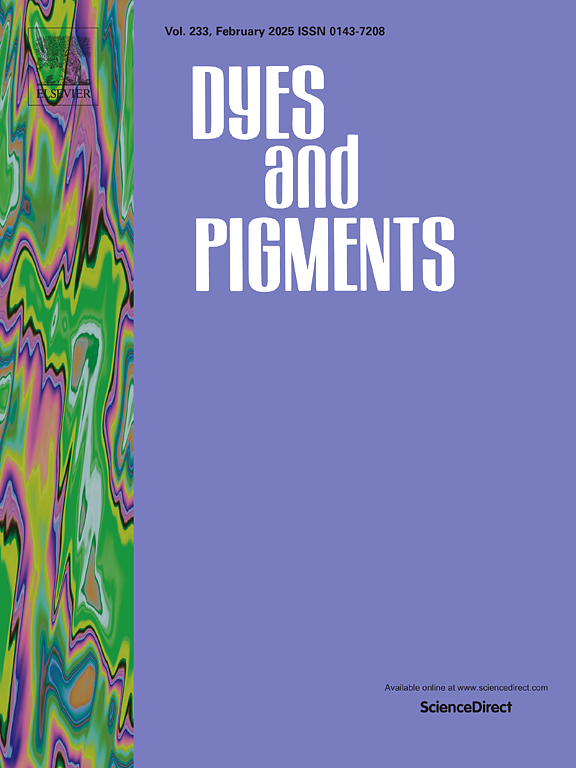Fluorinated electron acceptors synthesized via an inverse electron demand Diels-Alder click reaction for electrochromic conjugated polymers
IF 4.1
3区 工程技术
Q2 CHEMISTRY, APPLIED
引用次数: 0
Abstract
Fluorinated electron acceptors play a vital role in the development of conjugated polymers. They enhance electronic and optical properties by increasing electron affinity and improving charge transport characteristics. This work reports the synthesis of two fluorinated electron acceptors using an inverse electron demand Diels–Alder reaction, a type of click reaction, involving tetrazine with 1-ethynyl-4-fluorobenzene and 1-allyl-2,3,4,5,6-pentafluorobenzene, achieving yields of (73–82 %). One non-fluorinated polymer (P1) as a reference and two fluorinated polymers (P2 and P3) were prepared via the Stille polymerization. Notably, fluorinated polymer P2 showed better electrochromic device stability compared to the non-fluorinated polymer P1. The electrochromic devices exhibited coloration efficiencies of 196.97 cm2/C for P1, 519.49 cm2/C for P2, and 273.37 cm2/C for P3, suggesting that increased fluorination, either in the polymer backbone or in the side chains of conjugated polymers, likely contributes to the incremental increase in coloration efficiency. Polymer P2 demonstrated the best overall performance, with rapid switching times of 0.99 s for coloring, along with better cyclic stability than other two polymers. This study highlights that conjugated polymers modified with appropriate fluorine substituents can significantly enhance the performance of electrochromic devices.
含氟电子受体在共轭聚合物的开发中起着至关重要的作用。它们通过提高电子亲和力和改善电荷传输特性来增强电子和光学特性。本研究利用一种反电子需求 Diels-Alder 反应(点击反应的一种)合成了两种含氟电子受体,该反应涉及四嗪与 1-乙炔基-4-氟苯和 1-烯丙基-2,3,4,5,6-五氟苯,产率达到 73-82%。通过 Stille 聚合法制备了一种非氟聚合物(P1)作为参照物和两种氟聚合物(P2 和 P3)。值得注意的是,与非含氟聚合物 P1 相比,含氟聚合物 P2 显示出更好的电致变色装置稳定性。电致变色装置的着色效率分别为:P1 196.97 cm2/C,P2 519.49 cm2/C,P3 273.37 cm2/C。聚合物 P2 的整体性能最佳,着色的快速切换时间为 0.99 秒,其循环稳定性也优于其他两种聚合物。这项研究表明,用适当的氟取代基修饰共轭聚合物可显著提高电致变色装置的性能。
本文章由计算机程序翻译,如有差异,请以英文原文为准。
求助全文
约1分钟内获得全文
求助全文
来源期刊

Dyes and Pigments
工程技术-材料科学:纺织
CiteScore
8.20
自引率
13.30%
发文量
933
审稿时长
33 days
期刊介绍:
Dyes and Pigments covers the scientific and technical aspects of the chemistry and physics of dyes, pigments and their intermediates. Emphasis is placed on the properties of the colouring matters themselves rather than on their applications or the system in which they may be applied.
Thus the journal accepts research and review papers on the synthesis of dyes, pigments and intermediates, their physical or chemical properties, e.g. spectroscopic, surface, solution or solid state characteristics, the physical aspects of their preparation, e.g. precipitation, nucleation and growth, crystal formation, liquid crystalline characteristics, their photochemical, ecological or biological properties and the relationship between colour and chemical constitution. However, papers are considered which deal with the more fundamental aspects of colourant application and of the interactions of colourants with substrates or media.
The journal will interest a wide variety of workers in a range of disciplines whose work involves dyes, pigments and their intermediates, and provides a platform for investigators with common interests but diverse fields of activity such as cosmetics, reprographics, dye and pigment synthesis, medical research, polymers, etc.
 求助内容:
求助内容: 应助结果提醒方式:
应助结果提醒方式:


